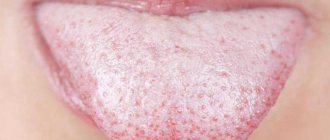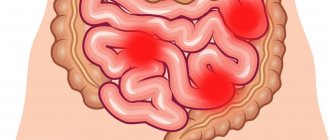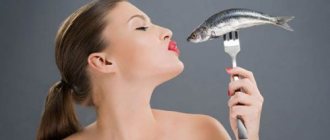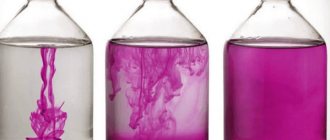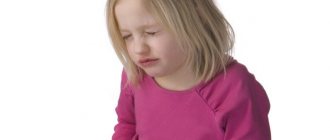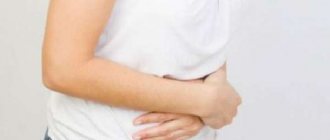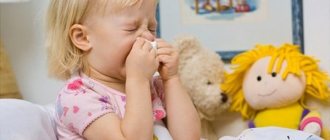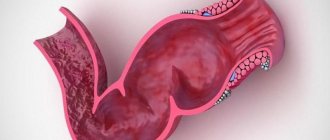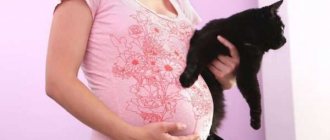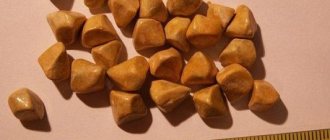Worms are a fairly common problem in children. Therefore, in kindergartens and schools, children are regularly tested for worm eggs. The reason for this is small hands that send an incredibly large number of microorganisms into the mouth every minute, plus the body’s low resistance to worms.
The acidity in the stomach of children is much lower than that of an adult, so they easily penetrate into other organs.
Medical science knows about 300 species of helminths (worms) that have the ability to live in the human body. On the territory of our country there are no more than 30 of them. Of these, the absolute majority are pinworms, roundworms and whipworms, which parasitize the intestines.
The most important symptom of infection with these worms is abdominal pain in a child. The pain is localized in the umbilical region, whipworms are localized in the lower abdomen on the right.
When palpated in this area, you can feel intestinal compaction, rumbling and soreness. But diagnosing a child’s stomach is the prerogative of a doctor; contact him if you suspect worms in a child.
Types of worms that affect children
Helminths that live and reproduce in the human body are divided into 3 groups:
- Nematodes, or roundworms - pinworms (the causative agent of enterobiasis), roundworms (the causative agent of ascariasis), trichinella (the causative agent of trichinosis), whipworm (the causative agent of trichocephalosis), etc. This group of helminths is most often found in young children.
- Cestodes, or flat (tape) worms - echinococcus, bovine tapeworm (causative agent of taeniarinosis), rat tapeworm (causative agent of hymenolepiasis), pork tapeworm (causative agent of taeniasis).
- Trematodes, or flukes – Siberian or cat fluke (the causative agent of opisthorchiasis), liver fluke (the causative agent of fascileosis), etc.
The localization of parasites is the digestive tract, liver, brain, lungs, heart, retina, bile ducts and gallbladder, pancreas. Helminth larvae and adults move throughout the body with the bloodstream.
How do children become infected and why?
The vast majority of cases of helminthic infestation are due to nematodes (ascariasis, enterobiasis, trichocephalosis). Infection with cestodes and trematodes accounts for 2 to 5% of all cases of helminthiasis. The cause of infection with tapeworms and flukes is travel to the tropics and subtropics, consumption of poorly fried or boiled meat, game, fish (infection with the broad tapeworm), as well as contact with animals that carry the infection.
Roundworms and pinworms enter a child's body when eating food with dirty hands, eating poorly washed berries, fruits and vegetables, and through contact with animals or carriers of ascariasis and enterobiasis.
When children are infected with pinworms, self-infection often occurs when the hands that the child used to scratch the skin around the anus transfer thousands of eggs onto toys, linen, household items, dishes, and door handles. He becomes infected again and infects his family members.
Children of primary preschool age taste everything that comes into their field of vision. Therefore, places where children have frequent contact with each other (playgrounds and kindergartens, playrooms in educational and shopping centers) become breeding grounds for helminth eggs. The defense system of a small child’s body is not yet perfect, and the need to observe hygiene rules has not yet developed.
The situation is aggravated by an imperfect system for detecting helminth infections. Erased symptoms, or their complete absence, may accompany the development of worms in children. This is why parents find it difficult to determine the causes of illness when complications of helminthiasis develop.
For example, the development cycle of pinworms makes it possible to detect symptoms of its presence only during a certain period of the development cycle. A scraping taken from a child at the wrong time may be false negative. That is why it is recommended to scrape the worm eggs three times: with a break of 2-3 days between them, and again, after 2 weeks.
Reasons for the increased risk of infection of children with ascariasis and enterobiasis:
- Irregular hand washing before eating, after a walk, or after contact with animals;
- Rare change of underwear, less than 2 times a day, or once in the morning.
- Persistent habit of putting toys in the mouth, sucking a finger, biting nails;
- Lack of nail care for children;
- Unsanitary conditions in the child’s home, the presence of flies and cockroaches;
- Contact with domestic animals that carry helminths on their fur and paws after a walk;
- Careless washing of vegetables, berries, herbs and fruits before eating.
Pirantel
Helmintox, Combantrin or Nemotsid. This is a popular anthelmintic medicine prescribed for the following helminthiasis: necatoriasis, ascariasis, hookworm, trichuriasis and enterobiasis. This drug is the preferred dewormer for children under 2 years of age because other medications are prescribed mainly to older children.
The scheme for using Pirantel is as follows:
- The drug is given to children in a dose of 125 mg per 10 kg of weight once with or after meals.
- When infected with roundworms and pinworms, Pirantel is repeated after 2 weeks to destroy those worms that have managed to grow from larvae during this time.
- During these 2 weeks, you need to carefully monitor the personal hygiene of children, iron their underpants with a hot iron and change them 2 times every day.
Pyrantel should not be given to children under 1 year of age or if they are individually sensitive to the drug. It is prescribed with caution to children with liver problems and during the treatment of myasthenia gravis. The medicine is usually well tolerated, but sometimes side effects such as loss of appetite, rash, headache, sleep disturbances, nausea, dizziness, urticaria, and diarrhea are possible.
General signs of worms in a child
Helminths are very dangerous for a child’s body, because the products of their vital activity and decay can cause serious intoxication and allergies, even toxic shock. In addition, helminths deprive the child of what is vital for full growth and development: vitamins and minerals. Their deficiency in the body also reduces the child's immunity, making him vulnerable to other diseases.
Worm infestation in children most often occurs in the warm season - late spring, summer and autumn, when children spend a lot of time outside, eat fresh, unwashed fruits, vegetables and berries with dirty hands and play with yard animals.
Symptoms of worms in children can be so unnoticeable or mild that a person does not feel that he is a carrier of the infestation. The activity of parasites is activated under unfavorable circumstances, with a decrease in the standard of living, and a decline in immunity. It is quite possible that worms are the cause of the appearance of some pathologies of internal organs and oncological processes.
The first symptoms of helminthic infestation in children are weakness and irritability. The child is capricious, sleeps poorly, complains of abdominal discomfort and headaches. There are changes in appetite: it either decreases or increases. Attacks of nausea and vomiting are also typical, and stool disturbances are observed (constipation alternating with diarrhea). Also, sometimes children may experience an increase in body temperature for no reason (up to 37.3 °C). In some cases, allergies to helminth waste products cause skin itching and rashes. Infected children have pale skin and dark circles around the eyes.
A clinical blood test for helminthic lesions of the body usually shows a high level of eosinophils, which indicates an allergic reaction. A decrease in hemoglobin is characteristic.
Medicines against worms for children from 2 to 3 years old
Mebex
A broad-spectrum drug. It causes irreversible disturbances in the mechanism of absorption and processing of glucose in the parasite, which ultimately leads to serious depletion of the harmful organism and the lack of opportunities for further existence. The dosage of the drug is selected taking into account the age of the child and is usually 25-50 mg of the active substance. If necessary, the same amount of Mebex can be taken again after 15-30 days if there is a high risk of re-infection or ineffectiveness of the previous dose. The drug is taken once after a meal.
Vormin
The drug Vormin is one of the best in its group
The drug is one of the best in its group. It also has a direct effect on the metabolic processes in the parasite’s body, preventing it from processing the necessary nutritional components. When the correct dose is selected, the affected worms come out naturally within the first two days. Vormin is taken only once; for the best effect, it should be taken after a meal with a small amount of liquid. The dosage of the active substance in childhood is 25-50 mg. Repeated use of Vormin is possible only if there is a high risk of relapse or low effectiveness of the initially prescribed dose. You can take the medicine a second time only after two weeks.
Vermox
Preparation Vermox
It is also relatively safe in childhood when properly selected doses are used. Like the drug described above, Vermox inhibits the absorption of active substances, specifically glucose, in parasites, after which they are severely depleted and cannot move through the digestive tract. This anthelmintic drug is considered safer and more effective than the Indian Vormin. Thanks to the more purified active substance, side effects when using Vermox are observed several times less often. The classic dosage of the active substance is 25-50 mg, repeated use is possible only if indicated.
Attention! At this age, experts also recommend the use of liquid forms of anthelmintic drugs, but if necessary and a good swallowing reflex, you can take tablets. Children most often experience nausea, vomiting, diarrhea, urticaria and stomatitis from taking anti-parasite medications during this age period.
Signs of pinworms in children
Pinworms are helminths that cause enterobiasis; they are small worms up to 1 cm long. An infected child scatters pinworm eggs in his environment, on clothes, door handles, toys, and dishes. For pinworms, UV radiation, boiling, and some disinfectants are dangerous. Pinworm eggs enter the mouth, and from there into the intestines. After a few days, larvae emerge from the eggs, they become sexually mature and are ready to reproduce and lay eggs. One life cycle of a pinworm is only 2 weeks.
A pronounced symptom of these worms in children is nighttime itching in the folds of the anus, when the body warms up in a warm bed and its muscles relax. The pinworm crawls onto the skin near the anus and lays more than 5,000 eggs in its folds. By scratching the irritated skin of the anal area, the child spreads these eggs under the nails. In addition to itching, you can find skin damage from scratching in a child.
Additional symptoms of enterobiasis in children:
- Restless sleep due to disturbing itching, possible insomnia, crying at night;
- Weight loss, insufficient weight gain due to age;
- Excitability, increased fatigue, moodiness, attention deficit, memory impairment;
- Enuresis in girls due to pinworms entering the urethra;
- Vulvovaginitis due to irritation of the vagina by helminths crawling there, less often - inflammation of the appendages and uterus;
- Development of acute appendicitis due to the accumulation of pinworms in the cecum;
- Night grinding of teeth is a presumptive symptom;
- Digestive disorders – dysbacteriosis, enterocolitis, diarrhea;
- Anemia, increased morbidity due to a deficiency of nutrients, vitamins, microelements;
- Intoxication phenomena as a consequence of toxic poisoning of the body (weakness, weight loss, nausea, headache).
Complications of helminthiasis in children
In order to avoid complications and consequences of helminthic infestations, it is important to identify and treat them in a timely manner. Then it will be possible to avoid the following serious, sometimes irreversible consequences in the form of:
- bronchial asthma, pleurisy and pneumonia;
- death if brain functionality is impaired;
- anemia;
- dysfunction of the visual analyzer;
- epilepsy;
- acute appendicitis;
- inflammatory processes in the organs of the reproductive system.
Signs of ascariasis in a child
According to statistics from laboratory studies, the incidence of worms in children is 80% of the total. Worms in children pose a serious problem for medicine, since worms deprive the child of nutrients and lead to organ pathologies and complications.
Ascariasis is one of the most dangerous types of worms in children. With a massive invasion, roundworms can penetrate any organ of the human body: intestines, liver, brain, lungs, pancreas, gall bladder, heart. Ascaris eggs enter the human mouth from the soil with dirty hands or food, where they are transferred from the soil, sand, legs of flies and cockroaches.
From the oral cavity, eggs with food enter the intestines, where they develop into larvae within 3 months. The grown larvae migrate through the blood vessels to other organs. Symptoms such as hyperthermia up to +38°C, weakness, dry cough with blood in the sputum, and increased fatigue appear. An X-ray examination reveals moving infiltrates in the lungs. Often a child with lung damage develops pneumonia, bronchitis, or bronchial asthma.
The primary phase of ascariasis is characterized by enlargement of the lymph nodes, liver, and spleen. Reaction to waste products of roundworms - allergic reactions in the form of urticaria of the hands and feet, dermatoses.
The secondary, late intestinal phase of ascariasis, which occurs 3 months after infection, roundworms return to the intestines. They get there along with sputum from the lungs swallowed by the child. Symptoms of this period are digestive disorders (abdominal pain, constipation, diarrhea, sudden weight loss, irritation of the anus, flatulence. Reduced immunity cannot protect the body from infections, pustular lesions of the skin and mucous membranes occur, stomatitis with frequent relapses.
The child’s nervous system suffers from the toxic effect of roundworms on the body. Children experience mental disorders - sleep disturbances, nightmares, epileptic seizures. Ascariasis causes serious consequences: inflammation of the peritoneum, appendicitis, intestinal obstruction due to the accumulation of a ball of roundworms in its lumen, obstructive jaundice due to the entry of larvae into the bile ducts.
Symptoms of the presence of worms
How to treat a child for helminths? First you need to confirm their presence in the body, and also determine the type of parasites. Common signs of helminthiases are:
- skin rash;
- headaches and dizziness;
- nausea, dyspepsia;
- poor sleep and anxiety;
- swollen lymph nodes;
- the appearance of periodic itching in the anus and abdominal pain;
- bitterness in the mouth;
- constant fatigue;
- allergic manifestations;
- muscle pain and a slight increase in body temperature without signs of a cold;
- yellowing of the skin and mucous membranes;
- The child grinds his teeth while sleeping at night.
To confirm the diagnosis, it is recommended to test feces three times to detect worm eggs, do a scraping for enterobiasis, and a blood test for other parasites.
Signs of other helminthic infestations
Worms in children trichocephalosis (caused by whipworm) - symptoms are minimal. Dyspepsia, bloody diarrhea, constipation, flatulence, anemia are possible; with prolonged intoxication, developmental delays in children of primary preschool age are diagnosed.
Another worm in children is hymenolepiasis (the causative agent is rat tapeworm) and has no specific symptoms. A disorder of the digestive tract may appear - abdominal pain, nausea and vomiting, constipation followed by diarrhea, heartburn. The child has decreased appetite, headache, increased salivation, allergic manifestations, rhinitis of unknown etiology.
Worms in children - opisthorchiasis (pathogen - Siberian fluke, cat fluke) - enlarged lymph nodes, allergic rashes, changes in blood count (ESR and the number of eosinophils are increased, hemoglobin is decreased). Additionally – low-grade fever, catarrh of the upper respiratory tract, digestive disorders. Symptoms of gastritis, hepatitis, pancreatitis, and myocardial dystrophy appear.
Diphyllobothriasis (the causative agent is the broad tapeworm, transmitted through fish that has not undergone full culinary processing) - anemia, allergies, digestive disorders, pain in the epigastric region.
Toxocariasis (caused by Toxocara) – carriers of the disease are domestic animals that transmit helminth eggs to humans. Preschoolers who come into contact with cats and dogs most often develop toxocariasis. Symptoms – allergic cough, itching, facial swelling, fever, hepatosis, enlarged lymph nodes. Eye damage is common - keratitis, chorioretinitis, ophthalmitis, which can become irreversible.
Mebendazole
Mebendazole or Vermox is an anthelmintic drug that is approved for use by children 2 years old and older children. Vermox is most effective for the following diseases: trichuriasis, hookworm, mixed infestations, ascariasis, enterobiasis.
Mebendazole is given to children in the following dosage:
- for enterobiasis – 1 tablet. 1 time (after 2 and 4 weeks the tablet is given again);
- for other invasions – 1 tablet. 3 days in a row, 2 times a day.
Vermox can also cause side effects, for example:
- headache;
- skin allergic manifestations;
- nausea;
- stomach ache;
- rise in temperature;
- dizziness;
- diarrhea;
- vomiting
Taking Vermox is contraindicated for those children who have ulcerative colitis, liver failure, or Crohn's disease. It is not prescribed for hypersensitivity to mebendazole.
Treatment of worms in children
Treatment of worms in children depends on the type of parasite and the degree of the disease. Drug therapy is usually required. It is also often necessary to take laxatives and follow a special diet. After the helminths are removed from the child’s body, he needs to restore immunity and normalize the functioning of the digestive system.
To prevent helminthiases, it is necessary to ensure that the child follows the rules of hygiene, eats washed fruits and vegetables, and drinks purified water and boiled milk.
How to remove worms from a child?
Modern drugs for the treatment of helminthiasis are divided into 2 categories, some have a wide spectrum of action, others are selectively active, they are selected for the treatment of a specific type of helminthic infestation. Self-medication during anthelmintic therapy is unacceptable, since drugs of this pharmacological group have severe toxicity. Only an infectious disease specialist or parasitologist can select the right remedy and therapeutic dose.
At the same time, antihistamines are prescribed to prevent an allergic reaction to drug components and waste products of worms. In the treatment of young children, drops and suspensions are used, for older children - tablets (Zyrtec, Loratadine, Zodak, Cetrin).
Medicines most often used for the treatment of nematodes in children and their analogues:
- Pyrantel (Pirvinium, Combantrin, Helmintox, Nemotsid);
- Decaris – Levamisole;
- Mebendazole (Termox, Wormin, Vermox, Mebex, Vermakar);
- Albendazole (Vormil, Nemozol, Gelmodol-VM).
The long-used drug Piperazine, the safest for children, has not lost its importance. In the treatment of severe invasion, Mebendazole is most effective. This remedy has a very valuable quality - it acts not only on adult helminths, but also on their eggs and larvae.
To eliminate the possibility of reinvasion, the course of treatment for enterobiasis is repeated after 2 weeks. Folk remedies in the form of preparations based on garlic, pumpkin seeds, enemas with decoctions of drugs, are taken to complement the main treatment, or for preventive purposes.
Effective and safe anti-worm tablets and suspensions for children
"Piperazine"
When treating roundworms or pinworms, it is safe to use the Piperazine suspension.
Children's drug in the form of a suspension. It acts on pinworms and roundworms, but does not destroy them, but destroys the nervous and muscular systems of the parasites. The disadvantage of the drug is that it does not kill worm eggs and larvae. Taking the drug may cause nausea, diarrhea, abdominal pain and headache. It is highly effective only in the initial stages of the disease. The advantage is that with such blocking of individuals no harmful toxin is released. And the remains of the worms will be excreted in the feces. This is the only drug in tablet form that can be given to children in the first years of life. Dosage - 200 mg. The best remedy to treat a disease such as parasites in children of any age.
"Pirantel"
A children's drug, prescribed from 6 months and indicated for children up to one year. An effective deworming remedy for children in the form of tablets or suspension. This is a drug with a wide spectrum of action: against ascariasis, enterobiasis, necatoriasis and hookworm. For ascariasis, a one-time dose is sufficient, repeated after 2-3 weeks. The downside of the drug is abdominal pain, lack of appetite, possible nausea and vomiting, rash and itching. The drug is contraindicated in children with renal colic and other kidney-related problems. Children one year old and up to 3 years old can take this drug as prescribed by a doctor, but for a child 4 years old and older it is less effective. There are 3 tablets in the package. The course of treatment depends on the disease. So, for ascariasis, 1 tablet at a dose of 10 mg/kg is enough. Refers to safe tablet drugs. Dosage - 10 mg/kg.
"Mebendazole"
For those over 2 years old. This is a strong drug; when taking it, you should be careful with the dosage. Side effects include liver dysfunction, abdominal pain and vomiting. In case of overdose - diarrhea, itching, fever, anemia. It is contraindicated to give to children under 2 years of age and to children with ulcers. But it is better to drink after 8 years.
"Albendazole"
The anthelmintic drug “Albendazole” has a wide spectrum of action.
This anthelmintic for children should be taken consciously and carefully, because it is characterized by a very strong effect. The downside is that there are many side effects, including diarrhea/constipation, stomatitis, hepatitis, vomiting, hallucinations, itching and fever. An anthelmintic is prescribed for ascariasis, hookworm and necatoriasis. This is not a long-term drug. The product is allowed to be consumed from 3 years of age.
"Levamisole"
Anti-worm suspension, available from 3 years of age. This product should not be taken by children or pregnant women. The product has a strong effect on the body. This remedy eliminates tapeworms and roundworms. You need to give your child 1 tablet per 5 kg of weight. It is used for nematodes, ascariasis and hookworm, therefore it is considered a broad-spectrum medicine. Although the drug will kill worms, it has many side effects.
Other substitute drugs
- "Nemotsid", "Kombantrin" and "Gilmintox" correspond to "Pirantel".
- "Vermox", "Mebex" and "Thermox" are substitutes for "Mebendazole".
- Analogues of the drug "Albendazole" are "Nemozol" and "Gelmodol".
- The only substitute drug for Levamisole is called Dekaris.
- Albendazole, Helmintox and Nemozol, Pirantel and Nemotsid are considered safe suspensions for children.
| Age: | It is allowed to prescribe anthelmintic drugs (names): |
| up to 6 months | no medications are prescribed |
| after 6 months | "Pyrantel" "Nemotsid" "Kombantrin" "Helmintox" |
| after 1 year | "Piperazine" "Enterofuril" |
| after 2 years | "Sanoxal", "Vormil", "Nemozil", "Aldazol" |
| after 3 years | "Vermox" "Nemazol", "Dekaris", "Albendazole" |
Prevention of helminthic infestations
Preventive measures for the prevention of helminthiasis:
- Instilling in children strong habits of hygiene (washing hands before eating, after visiting the toilet, prohibiting licking nipples, toys, household items that have fallen on the floor or the ground, sand);
- Elimination of the habit of biting nails, pencils, sucking fingers;
- Fight against mosquitoes, flies, cockroaches;
- Complete culinary processing of fish and meat (at least 40-60 minutes);
- Carrying out anthelmintic prophylaxis in domestic animals;
- Thoroughly wash vegetables and fruits before eating;
- Keeping the child’s nails in good condition, they should be clean and trimmed;
- Ironing children's underwear with a hot iron;
- Change the child's panties and wash the area near the anus in the morning and evening to prevent enterobiasis.
- To prevent pinworms from spreading across bedding, it is enough to dress your child in thick panties at night.
Prevention of helminthiasis in children
It is easier to prevent any disease than to cure it. Helminth infections are no exception. By eliminating the root causes of helminthic infestations, many problems with children's health can be avoided. For this it is enough:
- Make sure that pacifiers and toys are as sterile as possible.
- Wash your child's hands before eating. Remember that washing your hands with plain water does not solve the issue of their cleanliness. Only washing with soap helps to get rid of infectious agents on the surface of the skin of the hands.
- Trim and clean your child's nails regularly.
- Ironing clothes.
- Make sure that the child does not suck fingers or bite nails.
- Give your child only well-washed vegetables and fruits.
- Prevent the presence of flies in your home.
- Meat and fish dishes are well boiled.
- Do not let your child drink raw water.
- Fight helminthiases in pets.
Helminthiasis in children is a fairly common problem. Full responsibility for its decision lies with adults. To prevent the consequences of helminthic infestations from costing the health and life of your baby, it is necessary to deprive the parasites of the chance to penetrate the child’s body in order to suck out its juices, lay eggs in it, die and cause severe intoxication, and not allow the little one to grow and develop peacefully.
Treatment of helminthiases in children requires time and patience, qualified medical care and parental care.
